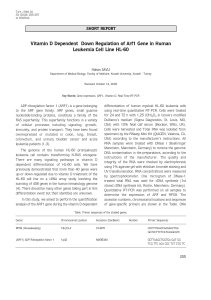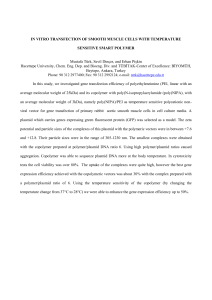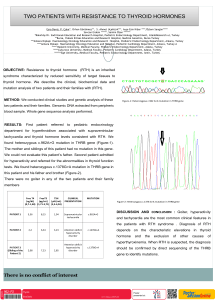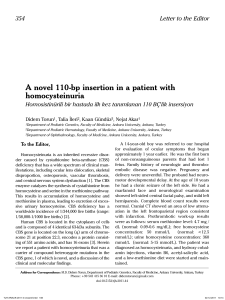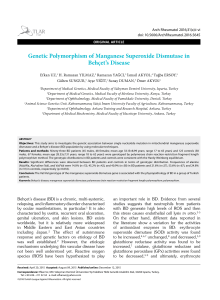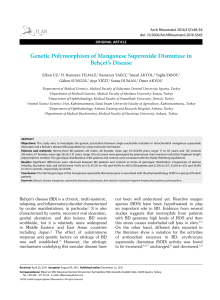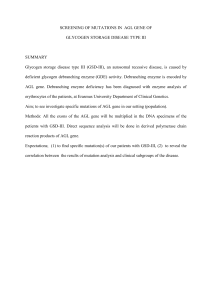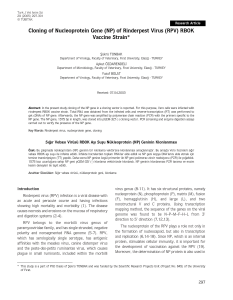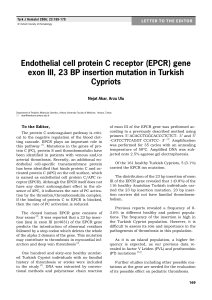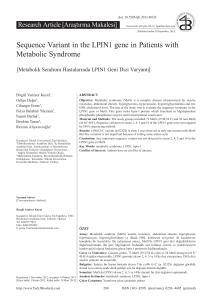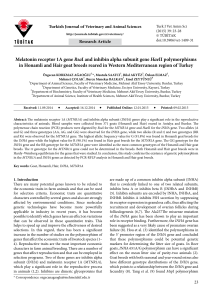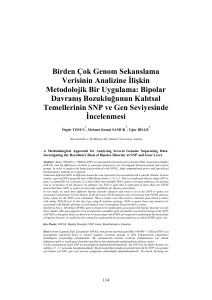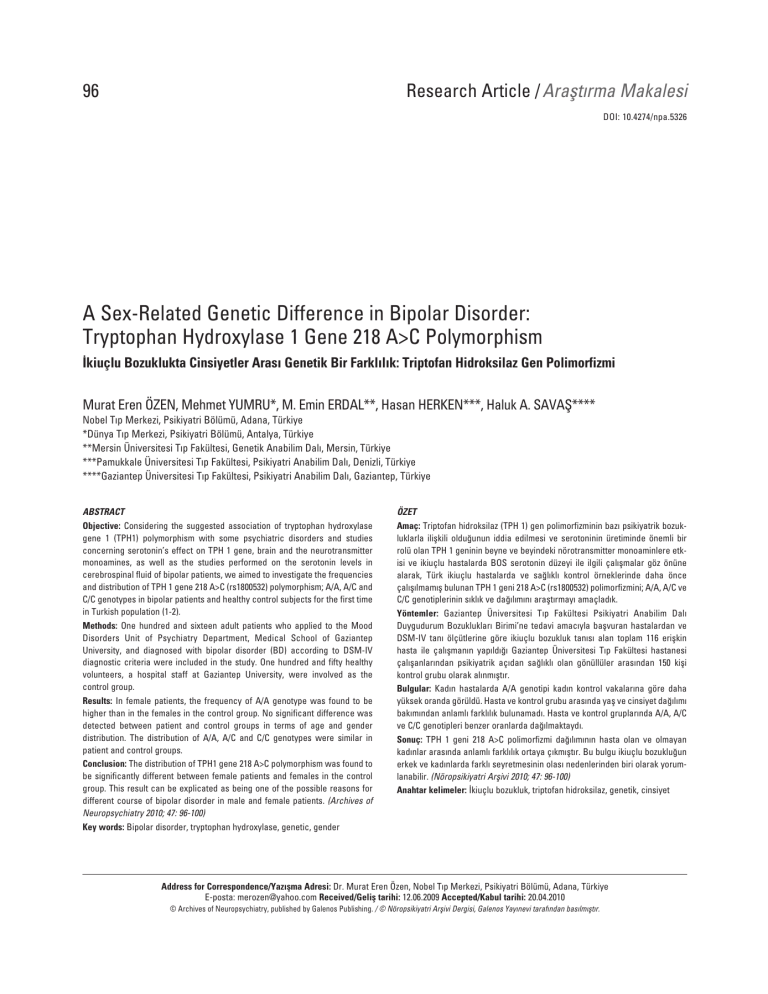
96
Research Article / Araflt›rma Makalesi
DOI: 10.4274/npa.5326
A Sex-Related Genetic Difference in Bipolar Disorder:
Tryptophan Hydroxylase 1 Gene 218 A>C Polymorphism
‹kiuçlu Bozuklukta Cinsiyetler Aras› Genetik Bir Farkl›l›k: Triptofan Hidroksilaz Gen Polimorfizmi
Murat Eren ÖZEN, Mehmet YUMRU*, M. Emin ERDAL**, Hasan HERKEN***, Haluk A. SAVAfi****
Nobel T›p Merkezi, Psikiyatri Bölümü, Adana, Türkiye
*Dünya T›p Merkezi, Psikiyatri Bölümü, Antalya, Türkiye
**Mersin Üniversitesi T›p Fakültesi, Genetik Anabilim Dal›, Mersin, Türkiye
***Pamukkale Üniversitesi T›p Fakültesi, Psikiyatri Anabilim Dal›, Denizli, Türkiye
****Gaziantep Üniversitesi T›p Fakültesi, Psikiyatri Anabilim Dal›, Gaziantep, Türkiye
ABSTRACT
Objective: Considering the suggested association of tryptophan hydroxylase
gene 1 (TPH1) polymorphism with some psychiatric disorders and studies
concerning serotonin’s effect on TPH 1 gene, brain and the neurotransmitter
monoamines, as well as the studies performed on the serotonin levels in
cerebrospinal fluid of bipolar patients, we aimed to investigate the frequencies
and distribution of TPH 1 gene 218 A>C (rs1800532) polymorphism; A/A, A/C and
C/C genotypes in bipolar patients and healthy control subjects for the first time
in Turkish population (1-2).
Methods: One hundred and sixteen adult patients who applied to the Mood
Disorders Unit of Psychiatry Department, Medical School of Gaziantep
University, and diagnosed with bipolar disorder (BD) according to DSM-IV
diagnostic criteria were included in the study. One hundred and fifty healthy
volunteers, a hospital staff at Gaziantep University, were involved as the
control group.
Results: In female patients, the frequency of A/A genotype was found to be
higher than in the females in the control group. No significant difference was
detected between patient and control groups in terms of age and gender
distribution. The distribution of A/A, A/C and C/C genotypes were similar in
patient and control groups.
Conclusion: The distribution of TPH1 gene 218 A>C polymorphism was found to
be significantly different between female patients and females in the control
group. This result can be explicated as being one of the possible reasons for
different course of bipolar disorder in male and female patients. (Archives of
Neuropsychiatry 2010; 47: 96-100)
Key words: Bipolar disorder, tryptophan hydroxylase, genetic, gender
ÖZET
Amaç: Triptofan hidroksilaz (TPH 1) gen polimorfizminin baz› psikiyatrik bozukluklarla iliflkili oldu¤unun iddia edilmesi ve serotoninin üretiminde önemli bir
rolü olan TPH 1 geninin beyne ve beyindeki nörotransmitter monoaminlere etkisi ve ikiuçlu hastalarda BOS serotonin düzeyi ile ilgili çal›flmalar göz önüne
alarak, Türk ikiuçlu hastalarda ve sa¤l›kl› kontrol örneklerinde daha önce
çal›fl›lmam›fl bulunan TPH 1 geni 218 A>C (rs1800532) polimorfizmini; A/A, A/C ve
C/C genotiplerinin s›kl›k ve da¤›l›m›n› araflt›rmay› amaçlad›k.
Yöntemler: Gaziantep Üniversitesi T›p Fakültesi Psikiyatri Anabilim Dal›
Duygudurum Bozukluklar› Birimi’ne tedavi amac›yla baflvuran hastalardan ve
DSM-IV tan› ölçütlerine göre ikiuçlu bozukluk tan›s› alan toplam 116 eriflkin
hasta ile çal›flman›n yap›ld›¤› Gaziantep Üniversitesi T›p Fakültesi hastanesi
çal›flanlar›ndan psikiyatrik aç›dan sa¤l›kl› olan gönüllüler aras›ndan 150 kifli
kontrol grubu olarak al›nm›flt›r.
Bulgular: Kad›n hastalarda A/A genotipi kad›n kontrol vakalar›na göre daha
yüksek oranda görüldü. Hasta ve kontrol grubu aras›nda yafl ve cinsiyet da¤›l›m›
bak›m›ndan anlaml› farkl›l›k bulunamad›. Hasta ve kontrol gruplar›nda A/A, A/C
ve C/C genotipleri benzer oranlarda da¤›lmaktayd›.
Sonuç: TPH 1 geni 218 A>C polimorfizmi da¤›l›m›n›n hasta olan ve olmayan
kad›nlar aras›nda anlaml› farkl›l›k ortaya ç›km›flt›r. Bu bulgu ikiuçlu bozuklu¤un
erkek ve kad›nlarda farkl› seyretmesinin olas› nedenlerinden biri olarak yorumlanabilir. (Nöropsikiyatri Arflivi 2010; 47: 96-100)
Anahtar kelimeler: ‹kiuçlu bozukluk, triptofan hidroksilaz, genetik, cinsiyet
Address for Correspondence/Yaz›flma Adresi: Dr. Murat Eren Özen, Nobel T›p Merkezi, Psikiyatri Bölümü, Adana, Türkiye
E-posta: [email protected] Received/Gelifl tarihi: 12.06.2009 Accepted/Kabul tarihi: 20.04.2010
© Archives of Neuropsychiatry, published by Galenos Publishing. / © Nöropsikiyatri Arflivi Dergisi, Galenos Yay›nevi taraf›ndan bas›lm›flt›r.
Archives of Neuropsychiatry 2010; 47: 96-100
Nöropsikiyatri Arflivi 2010; 47: 96-100
Özen et al.
A Sex-Related Genetic Difference in Bipolar Disorder: Tryptophan Hydroxylase 1 Gene 218 A>C Polymorphism
Introduction
Bipolar disorder (BD) is a chronic condition with onset in the
late adolescence and early adulthood, with relapsing symptoms
afterwards, and in which genetic predisposition is thought to be
the principal etiological factor. BD is seen equally among males
and females, and its incidence varies between 0.5 and 1.5% in
the general population (1).
Genetic predisposition is accepted to be the basis of the
disease, although infectious agents, labour trauma and
environmental factors are also suggested in the etiology of the
disorder (2).
Studies on families, twins and adopted children have
suggested significantly increased risk of the disease in
biological relatives of the patients. However, the type of genetic
linkage is yet to be identified. Genetic predisposition was
related with the effects of more than one susceptibility gene (2,3).
Various chromosomal disorders, gene locus and abnormalities
associated with BD were identified; however, all of the
studies are controversial (2,4).
Tryptophan hydroxylase 1 (TPH1) is the enzyme that
catalyzes the initial step in the biosynthesis of serotonin
(5-hydroxytryptamine, 5-HT). Pharmacologically, 5-HT is the
most active indoleamine. However, it rapidly loses its biological
activity when bounded to platelets or tissue cells. Availability of
tryptophan hydroxylase is the rate-limiting step of serotonin
synthesis. The enzyme TPH1 is encoded by gene localized to
11p15.3-p14. Polymorphism of this gene area causes regional
increase in tryptophan density and decrease in serotonin
density. TPH1 gene, which has a length of 29 kilobase (kb),
involves 11 exons of a single promotor and a single transcriptional
initiation sequence (5). In the studies on TPH gene, 12 polymorphisms
have been identified (6).
Neurobiological and genetic studies in patients with BD
suggest that this disease has a genetic basis. Catechol-O-methyl
transferase (COMT), 5-hydroxytryptamine transporter (5HTT)
and finally TPH1 genes were studied for this purpose. Serretti et
al., in a review of 169 patients with BD (103 type I, 66 type II) who
have suffered from a previous severe mania or hypomania
episode at least once, demonstrated that patients and controls
were comparable in respect to serotonin transporter (SERT),
TPH1, COMT and 5HT2A gene polymorphisms (7). Besides,
depressive patients cycling to mania/hypomania were shown
not to be different regarding the same gene polymorphisms. In
their study on SERT gene polymorphism in BD, Barlas et al. (8)
did not report a difference between patients and controls.
Serotonin level and activity in brain and cerebrospinal fluid
(CSF) are directly affected by the polymorphisms of TPH1 gene
(9,10). The influence of TPH1 gene polymorphisms on psychiatric
diseases has also been studied. Among studies investigating
the association of TPH1 gene polymorphism with BD (5,11,12),
impulsive-aggressive behaviors (13), activity alterations by
antidepressant treatment (14), suicidal behavior (15-17),
schizophrenia (18), nicotine addiction and smoking behavior (19)
and migraine (20,21), those on BD and TPH1 gene gave
contradictory results. Bellivier et al. made a comparison
between 152 BD patients and 94 healthy controls regarding
97
TPH1 gene alleles and despite the predisposition of TPH1 gene
to BD, they concluded that such kind of predisposition was not
present in case of suicidality (11). Rietschel et al. reported that
218 A>C polymorphism was not associated with this disease in
their 95 patients with BD (12). Serretti et al. compared 1424
patients with major psychoses, defined according to DSM IV
diagnostic criteria, with 380 healthy controls and investigated
TPH 1 gene 218 A>C gene variants (5). While TPH 1 gene
variants were not found to be associated with major psychoses,
it was observed that patients with BD had a high predisposition
to TPH1 gene A/A genotype. According to symptomatology,
male patients with TPH1 gene A allele were found to have lower
depressive symptoms compared to patients with TPH1 C allele,
although TPH1 gene 218 A>C variants did not exhibit a
significant difference. They suggested that TPH1 gene 218 A>C
variants were not the basic sensitivity factors for psychoses at
least in their sample, however, they determined that for male
patients TPH1 gene A allele containing variants might be a
protective factor for depressive symptoms or might be a subtype of mood disorder associated with manic symptoms of this
genotype. Possible factors, such as current age and disease
onset, age were not found to be affecting the observed results.
In summary, BD exhibits a genetic inheritance pattern involving
more than one gene (polymorphic-polygenic) and multiple
factors (multifactorial) (22,23).
Considering the studies concerning serotonin’s effect on
TPH1 gene, brain and the neurotransmitter monoamines in
addition to the studies concerning the serotonin levels of CSF in
bipolar patients (BD), we aimed with the present study to
investigate the frequencies and distribution of A/A, A/C and C/C
genotypes for the TPH1 gene 218 A>C (rs1800532) polymorphism
among patients with BD and healthy controls for the first time in
Turkish population.
Methods
a) Selection of Patient and Control Groups
One hundred and sixteen patients, diagnosed with BD,
according to DSM-IV diagnostic criteria, in the Mood Disorders
Unit, Psychiatry Department, Gaziantep University Medical
School, and 150 healthy subjects, a hospital staff at Gaziantep
University Medical School, were included as patient and control
groups, respectively. Informed written consents were obtained
from the patients and their relatives. Diagnosis was established
by at least two specialists. Venous blood samples (5 ml) were
drawn into ethylenediaminetetra acedic acid (EDTA) tubes from
all patients and control subjects, and kept under -20 °C until
DNA isolation. The patients, who were followed on treatment for
BD, and with recent onset of the disease, were included in the
study. Patients with mental retardation and chronic physical
disability were excluded from the study.
b) Molecular Genetic Analysis
DNA Extraction and Analysis
With written informed consent, a blood sample was drawn
from each individual. Venous blood samples were collected in
EDTA-containing tubes. DNA was extracted from whole blood
by salting-out procedure (24).
98
Özen et al.
A Sex-Related Genetic Difference in Bipolar Disorder: Tryptophan Hydroxylase 1 Gene 218 A>C Polymorphism
Genotypic Analysis of the TPH1 Gene 218 A>C
(rs1800532) Polymorphism
Polymerase chain reaction-restriction fragment length
polymorphism (PCR-RFLP) assays were used to determine TPH1
gene 218 A>C (rs1800532) polymorphism.
The oligonucleotide primers used to determine the TPH1
gene 218 A>C (rs1800532) polymorphism within the TPH1 gene
have been previously described (25). The primers,
forward 5’-TTCCATCCGTCCTGTGGCTGGTTA-3’; reverse
5’-TTTGAACAGCCTCCTCTGAAGCGC-3’, were used to amplify
the TPH1 gene. PCR was performed in a 25 μl volume with 50 ng
DNA, 100 μm dNTPs, 20 pmol of each primer, 1.5 mM MgCl2,
1x PCR buffer with (NH4)SO4 (Fermentas, Vilnius, Lithuania,) and
1U Taq DNA polymerase (Fermentas, Vilnius, Lithuania).
Amplification was performed on an automated Thermal Cycler
(Techne Flexigene, Cambridge, UK). PCR conditions were 3 min
for initial denaturation at 95°C; 35 cycles at 95°C for 45 s for
denaturation, 45 s at 68°C for annealing and 1 min at 72°C for
extension, followed by 7 min at 72°C for final extension. After
amplification, PCR products were digested by restriction
endonuclease 10 U NheI (Fermentas, Vilnius, Lithuania) for 14 h
at 37°C; the genotyping of the TPH1 gene was determined by
fragment separation at 120 V for 40-50 min on a 2.5% Agarose
gel containing 0.5 μg/ml ethidium bromide. A 100 bp marker
(100 bp DNA Ladder, Fermentas) was used as a size standard for
each gel lane. The gel was visualized under UV light using
visualization system for gel electrophoresis (Vilber Lourmat).
The NheI restricted products of TPH1 gene 218 A>C; A/A, A/C
and C/C genotypes had band sizes of 1024bp,
1024bp/660bp/364bp and 660bp/364bp, respectively. Genotyping
was based upon independent scoring of the results obtained by
two reviewers, who were unaware of case/control status.
c) Statistical Analysis
Distribution differences of TPH1 genotypes and alleles
between patients and controls were determined using
chi-square test and Fischer’s exact test. In calculation of average
of quantitative variables such as age distribution and education
time in subgroups of patients, student-t test was used in their
paired groups comparisons and ANOVA analysis was used in
the multigroup comparisons. Genotype distribution was
compared using Hardy-Weinberg equilibrium. P 0.05 was
considered as statistically significant.
Archives of Neuropsychiatry 2010; 47: 96-100
Nöropsikiyatri Arflivi 2010; 47: 96-100
Results
Patient group consisted of 116 subjects (52 females, 64
males) and control group consisted of 150 subjects (62 females,
88 males). The mean age of the patient group was 36.62±12.98
with age range of 20-73 years. The mean age of the control
group was 34.65±11.24 years. Age and gender distributions
were not significantly different between patients and the
control group (p>0.05).
The distribution of TPH1 genotypes in patients with BD was
as follows: A/A: 18 (15.5%), A/C: 49 (42.2%), C/C: 49 (42.2%). The
distribution in the control group was: A/A: 20 (13.3%), A/C: 69
(46.0%), C/C: 61 (40.6%) (Table 1). The distribution of A/A, A/C
and C/C genotypes in patient and control groups was
comparable (15.5%, 13.3%; 42.2%, 42.2%; 46%, 40%) (χ2=0.46,
df=2, p>0.05). Genotype distribution among the groups was in
Hardy-Weinberg equilibration.
Among patients with BD, A allele was found in 85 (36.6%)
and C allele in 147 (63.3%) patients, whereas in the control
group, A allele was found in 109 (36.3%) and C allele in 191
(63.6%) subjects (χ2=0.00, df=1, p>0.05).
When both groups were divided into two new groups
according to the presence and absence of C allele (C/C and A/C
genotype versus A/A genotype), 58 patients (90.6%) and 72 control
subjects (82.7%) had C allele, whereas 6 patients (9.3%) and 15
control subjects (17.2%) did not have C allele (χ2=9.37, df=8, p>0.05).
When the subjects in both groups were divided into two
groups according to the presence and absence of A allele
(A/A and A/C genotype versus C/C genotype), 35 patients
(54.6%) and 51 control subjects (58.6%) had A allele, whereas 29
patients (45.3%) and 36 control subjects (41.3%) did not have A
allele (χ2=0.23 df=1, p>0.05).
The distribution of genotypes in male patients and male
controls were as follows: A/A (6: 9.3%; 16: 18.1%), A/C (29: 45.3%;
36: 40.9%) and C/C (29: 45.3%; 36: 40.9%) (p>0.05). The distribution
of genotypes in female patients and female controls were as:
A/A (23.0%; 6.4%), A/C (38.4%; 53.2%) and C/C (38.4%; 40.3%)
(p>0.05). A/A genotype had the lowest frequency in patient and
control groups. The frequency of A/A genotype was the lowest
among female controls (Table 2). The frequency of A/A genotype
in female patients was significantly higher compared to
female controls (χ2=6.92, df=2, p<0.05).
Table 1. Genotype distribution in BD and control samples
A/A (%)
A/C (%)
C/C (%)
Total (%)
BD
18 (15.5)
49 (42.2)
49 (42.2)
116 (100.0)
Control
20 (13.3)
69 (46.0)
61 (40.6)
150 (100.0)
Total
38 (14.2)
118 (44.3)
110 (41.3)
266 (100.0)
A/A (%)
A/C (%)
C/C (%)
Total (%)
Patient
12 (23.0)
20 (38.4)
20 (38.4)
52 (100.0)
Control
4 (6.4)
33 (53.2)
25 (40.3)
62 (100.0)
16 (14.0)
53 (46.4)
45 (39.4)
114 (100.0)
(χ2=0.46, df=2, p>0.05)
Table 2. Genotype distribution in female patients and female controls
Total
(χ2=6.92 df=2 p=.031)
Archives of Neuropsychiatry 2010; 47: 96-100
Nöropsikiyatri Arflivi 2010; 47: 96-100
Özen et al.
A Sex-Related Genetic Difference in Bipolar Disorder: Tryptophan Hydroxylase 1 Gene 218 A>C Polymorphism
Discussion
The influence of TPH gene polymorphisms on psychiatric
diseases has been studied. Zill et al. suggested an association
between TPH2 gene variants and major depression (26). Eley et
al. studied gene-environment interactions, 5HTT, 5HTR2A,
5HTR2C, monoamine oxidase subtype A (MAOA) and TPH1
genes in depressions during adolescence (27). They suggested
that among depressive patients, particularly females,
environmental risks together with SERT gene are important.
HTR2A and TPH1 genes were important predictors independent
of the effects and interactions of environmental risk and gender
factor. Rotondo et al. reported that the distribution of TPH1
polymorphism was different in bipolar patients with panic
disorder compared to bipolar patients without panic disorder
(28). They also supported the hypothesis, which suggests that
patients with accompanying panic disorder would be a
separate subtype of BD.
Cusin et al. reported that there is no difference in the
frequency of TPH1 gene among patients with unipolar depressions,
BD and rapid-cycling BD (29). Serretti et al. reported less
depressive symptoms in male patients with TPH1 A allele
compared to patients with TPH1 gene C allele, although TPH1
gene 218 A>C gene variant was not different between groups
(5). They suggested that variants containing TPH1 gene A allele
might be a protective factor for depressive symptoms in male
patients or this genotype might be related to a subtype of mood
disorders characterized by manic symptoms.
Furlong et al. could not find a significant difference between
patients with affective disorder with or without suicide attempts
in respect to TPH1 gene polymorphism (30). Sourey et al.
reported no difference in TPH1 218 A>C polymorphism in
patients with unipolar or bipolar mood disorder, however, the
frequency of C/C genotype was higher among patients with
unipolar mood disorder having history of suicide attempt
compared to the controls (31). Serretti et al. reported that
bipolar and depressive patients having TPH1 A/A genotype had
poor response to lithium therapy (32).
Serretti et al. reported poor response to therapy with
serotonin reuptake inhibitors in depressive and bipolar
depressive patients having TPH1 A/A genotype (24).
Mizuno et al. demonstrated a lack of relationship between
smoking and TPH1 218 A>C gene polymorphism in Japanese
population, but confirmed the early onset of smoking in patients
with A/A genotype (33). Sekizawa et al. suggested a two-fold
increased risk of early onset schizophrenia in children with
TPH1 A/A genotype compared to the other genotypes (34).
The major evidence in our study is the observation of A/A
genotype at higher frequency in female patients than female
controls. Neither genotype nor allele distribution differences
were present between patient and control groups with regard
to the other variables. Also according to gender, no difference
was established regarding genotype and allele distributions
among patients.
Y›ld›z et al. reported a gender-specific relationship between
rapid cycling and use of antidepressants, prior to the first episode
of mania/hypomania in patients with BD (35). They suggested
that the use of antidepressants would be associated with an
99
increased risk of rapid cycling in female patients compared to
males. This suggests that gender factor and serotonergic
system should be considered in the context of BD.
We herein report different distribution of TPH1 gene 218 A>C
gene polymorphism between patients and healthy controls
which could be explained by different clinical presentation and
course in male and female patients with BD. Furthermore, this
gene polymorphism would be a contributing factor in female
patients for the development of the disease. This is the first
study demonstrating the female gender-related difference in
TPH1 gene polymorphism among patients with BD.
In conclusion, the relation between BD and TPH1 gene 218
A>C polymorphism demands further investigations. Studies are
required containing independent samples with higher number
of patients. Focusing on the phenotypic subtypes of the disease
would enable us to conduct studies on a relatively homogenous
population and would give us the opportunity to identify the
genes influencing a complex disease. Possible important
subtypes of TPH gene polymorphism are: BD with or without
suicidal behavior, early or late onset, rapid cycling, responsiveness/
irresponsiveness to lithium therapy. Future studies on the
association of genes with the clinical signs and symptoms, and
the course of the disease (number and type of attacks, etc)
would open up new horizons.
References
1.
2.
Meiser B, Mitchell PB, McGirr H et al. Implications of genetic risk
information in families with a high density of bipolar disorder:
an exploratory study. Soc Sci Med 2005; 60:109-8. [Abstract] / [PDF]
Belmaker RH. Bipolar disorder. N Engl J Med 2004; 351:476-86.
[Abstract] / [Full Text] / [PDF]
3.
4.
Savafl HA. ‹ki uçlu bozuklukta genetik polimorfizm çal›flmalar›.
3P Dergisi 2004; 12:39-48. [Abstract]
Porteous DJ, Evans KL, Millar JK et al. Blackwood DH. Genetics of
schizophrenia and bipolar affective disorder: strategies to identify
candidate genes. Cold Spring Harb Symp Quant Biol 2003; 68:383-94.
[Abstract] / [PDF]
5.
Serretti A, Lilli R, Lorenzi C et al. Tryptophan hydroxylase gene and
major psychoses. Psych Res 2001; 103:79-86. [Abstract] / [Full Text] /
[PDF]
6.
Shen P, Buchholz M, Sung R et al. Population genetic implications
from DNA polymorphism in random human genomic sequences.
Human Mutat 2002; 20:209-217. [Abstract] / [PDF]
7. Serretti A, Cusin C, Rossini D et al. Further evidence of a combined
effect of SERTPR and TPH on SSRIs response in mood disorders.
Am J Med Genet 2004; 129:36-40. [Abstract] / [Full Text] / [PDF]
8. Barlas O, Savafl HA, Arslan A ve ark. “‹ki uçlu bozuklukta Serotonin
Tafl›y›c› Gen Polimorfizmi” 38. Ulusal Psikiyatri Kongre Kitab›,
Marmaris. 2002, 35.
9. Hoogendoorn B, Coleman SL, Guy CA et al. Functional analysis of
polymorphisms in the promoter regions of genes on 22q11. Hum Mutat
2004; 24:35-42. [Abstract] / [PDF]
10. Kelsoe JR, Niculescu AB 3rd. Finding genes for bipolar disorder in the
functional genomics era: from convergent functional genomics to
phenomics and back. CNS Spectr 2002; 7:215-26. [Abstract] / [PDF]
11. Bellivier F, Leboyer M, Courtet P et al. Association Between the
Tryptophan Hydroxylase Gene and Manic-depressive illness. Arch
Gen Psychiatry 1998; 55:33-7. [Abstract] / [Full Text] / [PDF]
12. Rietschel M, Schorr A, Albus M et al. Association Study of the
Tryptophan Hydroxylase Gene and Bipolar Affective Disorder Using
Family-Based Internal Controls. Am J Med Gen (Neuropsych Gen)
2000; 96:310-1. [Abstract] / [Full Text] / [PDF]
100
Özen et al.
A Sex-Related Genetic Difference in Bipolar Disorder: Tryptophan Hydroxylase 1 Gene 218 A>C Polymorphism
13. Staner L, Uyan›k G, Correa H et al. A Dimensional Impulsive-Aggressive
Phenotype Is Associated With the A218C Polymorphism of the
Tryptophan Hydroxylase Gene: A Pilot Study in Well-Characterized
Impulsive Inpatients. Am J Med Gen (Neuropsych Gen) 2002; 114:553-7.
[Abstract] / [Full Text] / [PDF]
14. Serretti A, Zanardi R, Cusin C et al. Tryptophan hydroxylase gene
associated with paroxetine antidepressant activity. Eur
Neuropsychophar 2001; 11:375-80. [Abstract]
15. Nielsen DA, Jenkins GL, Stefanisko KM et al. Sequence, splice site
and population frequency distribution analyses of the polymorphic
human tryptophan hydroxylase intron 7. Mol Brain Res 1997; 45:145-8.
[Abstract] / [PDF]
16. Zalsman G, Frisch A, King RA et al. Case Control and Family-Based
Studies of Tryptophan Hydroxylase Gene A218C Polymorphism and
Suicidality in Adolescents. Am J Med Gen (Neuropsych Gen) 2001;
105:451-7. [Abstract] / [Full Text] / [PDF]
17. Bellivier F, Chaste P, Malafosse A. Association Between the TPH
Gene A218C Polymorphism and Suicidal Behavior: A Meta-Analysis.
Am J Med Gen Part B (Neuropsych Gen) 2004; 124:87-91. [Abstract] /
[Full Text] / [PDF]
18. Hong CS, Tsai SJ, Wang YC. Association between tryptophan
hydroxylase gene polymorphism (A218C) and schizophrenic disorders.
Schizophrenia Research 2001; 49:59-63. [Abstract] / [Full Text] / [PDF]
19. Lerman C, Caporaso NE, Bush A et al. Tryptophan Hydroxylase Gene
Variant and Smoking Behavior. Am J Med Gen (Neuropsych Gen)
2001; 105:518-20. [Abstract] / [Full Text] / [PDF]
20. Estevez M, Estevez AO, Cowie RH et al. The voltage-gated calcium
channel UNC-2 is involved in stress-mediated regulation of tryptophan
hydroxylase. J Neurochem 2004; 88:102-13. [Abstract] / [Full Text] / [PDF]
21. Erdal N, Erdal ME, Çamdeviren H ve ark. Bir Grup Sa¤l›kl› Gönüllüde
Katekol-O-Metiltransferaz (COMT) Gen Polimorfizmi. Klinik Psikofarmakoloji Bülteni 2004; 20:14:2. [Abstract] / [PDF]
22. Sourney D, Masat I, Mendlewicz J. Genetics of bipolar disorders.
Acta Neuro Psychiatrica 2000; 12:65-68.
23. Berettini WH, Ferraro TN, Goldin LR. A linkage study of bipolar illness.
Arch Gen Psychiatry 1997; 54:27-35. [Abstract] / [PDF]
24. Miller SA, Dykes, DD, Polesky HF. A simple salting out procedure for
extracting DNA from human nucleated cells. Nucleic Acids Research
1988; 16:1215. [Abstract] / [PDF]
Archives of Neuropsychiatry 2010; 47: 96-100
Nöropsikiyatri Arflivi 2010; 47: 96-100
25. Nielsen DA, Jenkins GL, Stefanisko KM et al. Sequence, splice site
and population frequency distribution analyses of the polymorphic
human tryptophan hydroxylase intron 7. Brain Res Mol Brain Res 1997;
45:145-8. [Abstract] / [PDF]
26. Zill P, Baghai TC, Zwanzger P et al. SNP and haplotype analysis of a
novel tryptophan hydroxylase isoform (TPH2) gene provide evidence
for association with major depression. Mol Psychiatry 2004; 9:1030-6.
[Abstract] / [Full Text] / [PDF]
27. Eley TC, Sugden K, Corsico A et al. Gene-environment interaction
analysis of serotonin system markers with adolescent depression.
Mol Psychiatry 2004; 9:908-15. [Abstract] / [Full Text] / [PDF]
28. Rotondo A, Mazzanti C, Dell'Osso L et al. Catechol o-methyltransferase,
serotonin transporter, and tryptophan hydroxylase gene polymorphisms
in bipolar disorder patients with and without comorbid panic disorder.
Am J Psychiatry 2002; 159:23-9. [Abstract] / [Full Text] / [PDF]
29. Cusin C, Serretti A, Lattuada E et al. Influence of 5-HTTLPR and TPH
variants on illness time course in mood disorders. J Psychiatr Res
2001; 35:217-23. [Abstract] / [PDF]
30. Furlong RA, Ho L, Rubinsztein JS et al. No association of the tryptophan
hydroxylase gene with bipolar affective disorder, unipolar affective
disorder, or suicidal behavior in major affective disorder. Am J Med
Genet 1998; 81:245-7. [Abstract] / [PDF]
31. Sourey D, Van Gestel S, Massat I et al. Tryptophan hydroxylase
polymorphism and suicidality in unipolar and bipolar affective
disorders: a multicenter association study. Biol Psychiatry 2001;
49:405-7. [Abstract] / [Full Text] / [PDF]
32. Serretti A, Lilli R, Lorenzi C et al. Tryptophan hydroxylase gene and
response to lithium prophylaxis in mood disorders. J Psychiatr Res
1999; 33:371-7. [Abstract] / [PDF]
33. Mizuno S, Ito H, Hamajima N et al. Association between smoking
habits and tryptophan hydroxylase gene C218A polymorphism among
the Japanese population. J Epidemiol 2004; 14:94-9. [Abstract] / [PDF]
34. Sekizawa T, Iwata Y, Nakamura K et al. Childhood-onset schizophrenia
and tryptophan hydroxylase gene polymorphism. Am J Med Genet
2004; 128:24-6. [Abstract] / [Full Text] / [PDF]
35. Yildiz A, Sachs GS. Do antidepressants induce rapid cycling?
A gender-specific association. J Clin Psychiatry 2003; 64:814-8.
[Abstract] / [PDF]

